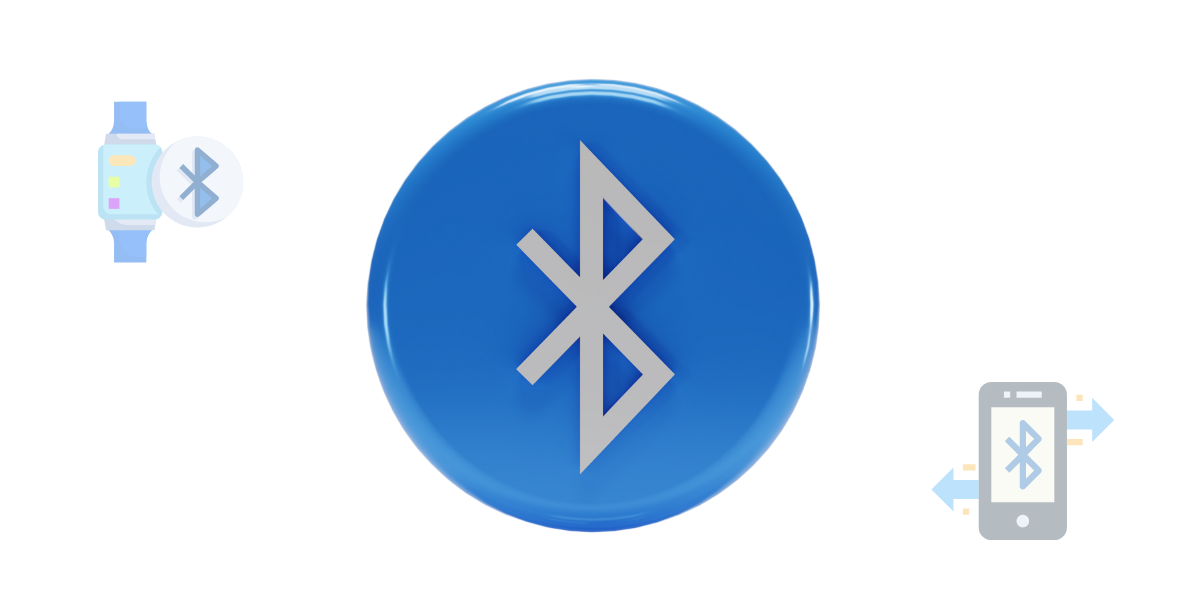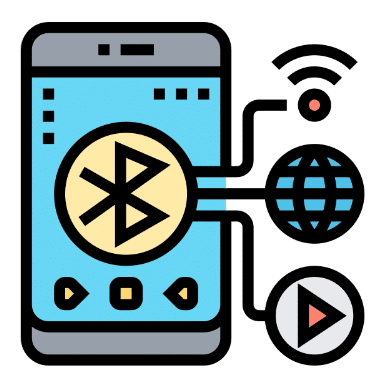What Is BLE (Bluetooth Low Energy) and How Does It Work?
Posted by iCoverLover on May 15, 2023
Bluetooth Low Energy uses identical technology to standard Bluetooth but uses much less energy. Where is this useful and how does it all work?
Bluetooth is a feature that most of us use on a daily basis. The same applies to a large proportion of wireless computer peripherals (keyboards, mice, headsets...). It's a feature without which modern connectivity would be severely curtailed.
Today's smart devices support another wireless standard, namely Bluetooth Low Energy (BLE). Since its launch, BLE has become the default technology for connecting to smart devices such as speakers, headphones, smartwatches and fitness trackers.
BLE features the same wireless connectivity as we are used to with standard Bluetooth, but it does so with significantly less energy consumption. Its use is not only limited to the aforementioned portable and wearable devices, but we can expect audio products supporting the latest Low Energy Audio standard to dominate the audio market in the future. The latter supports the new audio codec LC3 (Low Complexity Communication Codec), which promises transmission at very low bit rates while maintaining good sound quality. It will all be enabled by Bluetooth Low Energy.

What is Bluetooth Low Energy (BLE)?
Bluetooth Low Energy (LE) is a part of the original Bluetooth standard, now often referred to as Bluetooth Classic. If you've ever read product specs and noticed version numbers like Bluetooth 5.2, you already know the classic version. Most smartphones support both Bluetooth standards.
BLE saw the light of day in 2010 under the guidance of the Bluetooth Special Interest Group (SIG). It was designed as a subset of the original Bluetooth 4.0. The name itself immediately reveals that it is a standard that emphasises the economy.
How does it achieve this economy? BLE sends fewer data packets at longer time intervals. This means that devices can stay in a deep sleep state most of the time and only connect every few minutes to send new data packets. Classic Bluetooth for the same connection involves continuous transmission and consequently higher consumption.
From this point of view, it is completely understandable why BLE is ideal for smartwatches, bracelets, headphones and other smaller devices. These devices do not need constant communication. New information, for example, distance travelled, heart rate, and possible notifications, are not critical to our everyday life, so we do not need them at that exact moment. Devices can take their time and send these data packets after a certain time interval.
Bluetooth Low Energy also plays a significant role in the Internet of Things (IoT), which is the network of physical devices and items embedded with sensors, software, and other technologies to connect and exchange data over the Internet. BLE is particularly valuable in the IoT space due to its low power consumption and its ability to facilitate communication between devices.
Bluetooth Low Energy is a mature technology. It has been present in Apple devices since iOS 5.0, while Android introduced the technology with Android Jellybean (4.3). Its use has also extended beyond commercial waters. It is used in logistics, navigation and sports.
What are the benefits of Bluetooth LE?
Lower consumption is just one of the advantages of the economical Bluetooth Low Energy standard. It also contains some other useful capabilities:
Quick and easy pairing: Have you ever noticed that many modern wireless devices don't require you to enter a password or PIN during pairing? That's because Bluetooth LE offers a special pairing mode called "Just Works" that allows two devices to pair without manual user input. This is especially useful for devices that don't have a screen or keyboard, audio products, and wearables.
NFC has the same function, but it has a shorter range and offers better protection in crowded places.
Advertising mode: This mode refers to a state in which a device broadcasts packets of data in intervals to signal its presence to nearby devices. This allows devices like smartphones to discover and connect to the advertising device.
Positioning and Tracking: A common use of BLE is to track the location of objects via wireless transmitters. These are basically small, low-power devices that transmit a signal to nearby devices. BLE transmitters, identified by their unique ID numbers, allow you to pinpoint the location of an object. Similarly, the sports industry uses BLE in sports equipment to measure performance and other metrics.
RFID tags and accompanying technology are also used to find objects, with which they recently proved that X-ray vision is a concept with a lot of potentials.
Home automation: Because of its low power consumption, BLE is a perfect fit for battery-powered sensors that record temperature, humidity, light, and human presence.
Efficient audio streaming: Until recently, all wireless audio streaming products had to use classic Bluetooth. However, in 2022 the Bluetooth SIG introduced a new standard that finally brings audio support for low-cost BLE. Briefly, Bluetooth Low Energy Audio uses the new LC3 audio codec for improved audio quality at lower bit rates.
Comparison of Bluetooth and Bluetooth LE. What's the difference?
The original Bluetooth standard, introduced in 1999, was designed for fast data transfer. Infrared technology at the time was not sufficient for the needs of people, so Bluetooth was accepted with open arms. 10 years later, user requests triggered the development of a low-power wireless protocol.
Bluetooth LE is inferior to classic in two respects: range and data transfer speed. The low power consumption means that it can only maintain a maximum range of about 30 meters. This is less than a third of the Bluetooth standard (of course, the range depends on a number of factors such as the type of device and other interference in the environment). This is not even a fault. Wearables and most other BLE devices do not work over long distances.
Main differences:
- Bluetooth provides continuous two-way communication. BLE communicates in short intervals and some connections are unidirectional.
- Bluetooth BLE reaches speeds between 125 Kbps and 2 Mbps. Classic Bluetooth is between 1 and 3 Mbps.
- Bluetooth can be used to transmit voice, but BLE generally cannot. The same applies to video signals.
- The latency for Bluetooth connections is around 100 milliseconds. BLE boasts lower latency times – around 6 milliseconds.
- BLE consumes between 0.01 and 0.5 W, while Bluetooth consumes around 1 W of power.
How secure is Bluetooth LE?
All BLE connections are equipped with AES-128 end-to-end encryption. This prevents the data from being read if it is ever intercepted.
Man-in-the-middle attacks are possible, but this can only happen for the period that two BLE devices are paired. The limited range of BLE is also beneficial from a security point of view. Any attempt to hack into a BLE device will require the hacker to get physically close to it.
BLE Compatibility

Any device that supports Bluetooth 4.0 or higher will also support BLE. This includes many modern smartphones, tablets, computers, and various Internet of Things (IoT) devices like fitness trackers, smartwatches, and smart home devices. It's important to note that while a device might support BLE, the specific services and characteristics it supports can vary. For instance, a heart rate monitor and a smart light bulb both might use BLE, but they offer different services and have different ways of interacting with other devices.
Moreover, BLE is backward compatible with previous versions. That means devices supporting newer versions of Bluetooth (like 5.0 or 5.2) can still communicate with devices using Bluetooth 4.0. However, devices that only support older Bluetooth versions (3.0 and earlier) won't be able to communicate via BLE as they lack the necessary hardware and software support. In these cases, a device would need to use the classic Bluetooth protocol for communication, which is more power-intensive.
One thing to keep in mind is that for two devices to communicate using BLE, they don't necessarily need to have the same Bluetooth version. They should be able to connect as long as they both support BLE.
Do phone cases affect BLE?
In general, mobile cases should not significantly affect the performance of Bluetooth Low Energy (BLE) or any other wireless communications from your phone. This is because BLE, like other forms of Bluetooth, operates at a frequency (2.4 GHz) that can penetrate most non-metallic materials, which is what most phone cases are made of.
However, there may be some exceptions:
Metallic or Very Thick Cases: Cases made of metal or significantly thick materials may potentially interfere with the Bluetooth signal. This is because metal can reflect electromagnetic waves, including the 2.4 GHz waves used by Bluetooth.
Cases with Built-In Electronics: Some phone cases come with built-in electronics, like battery cases or cases with built-in LED lights. Depending on the design of these cases, they could potentially interfere with BLE signals.
Cases Covering Antenna Lines: Modern smartphones often have antenna lines built into their frames. If a case is designed in such a way that it covers these lines, it could potentially affect the signal.
While these factors might cause some degree of signal degradation, in most typical scenarios and with most standard phone cases, you're unlikely to notice a significant impact on your phone's Bluetooth performance. If you're experiencing issues with Bluetooth connectivity, it's more likely that the cause is something else, such as interference from other devices or a software problem.
Conclusion
Bluetooth Low Energy (BLE) is a power-efficient version of the classic Bluetooth technology designed for short-range communication between devices. This technology was part of the Bluetooth 4.0 specification and is specifically designed for low power consumption. It's primarily used in applications that require infrequent short bursts of data transfer and can run for long periods on power sources as small as coin cell batteries. Many smartphone applications utilise BLE to provide their services. For instance, a fitness application can access data from a BLE-enabled heart rate monitor or a pedometer. Similarly, home automation apps can control smart home devices via BLE, like lights or thermostats. BLE devices can adjust their transmission power according to the needed range. Devices that need only a short transmission range can operate at lower power, thus extending battery life.
Unlike traditional Bluetooth, which constantly maintains a connection, BLE remains in sleep mode until a connection is initiated. The actual connection times can be as short as a few milliseconds, which helps save power. A key aspect of BLE is its ability to operate with low-cost, off-the-shelf components. It can also work in a broadcast mode, which allows data to be sent to many devices at once – a feature useful in applications like retail advertising and indoor location tracking.
